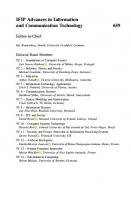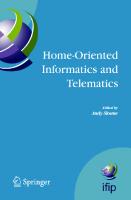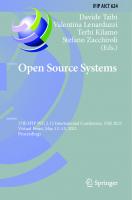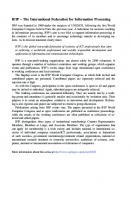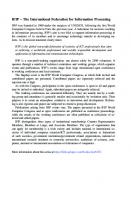Ad-Hoc Networking: IFIP 19th World Computer Congress, TC-6, IFIP Interactive Conference on Ad-Hoc Networking, August 20-25, 2006, Santiago, Chile (IFIP ... in Information and Communication Technology) [1 ed.] 038734635X, 9780387346359, 9780387347387
This volume presents proceedings from the 19th IFIP World Computer Congress in Santiago, Chile. The proceedings of the W
237 97 11MB
English Pages 189 Year 2006
Table of Contents......Page 6
1. TCP Performance over Geo-routing for High Mobility: Vehicle Grids and Airborne Swarms......Page 8
2. An Efficient QoS Routing Protocol for Mobile Ad-Hoc Networks......Page 23
3. On a QoS Intrusion Tolerant Routing protocol in Ad-hoc Networks......Page 35
4. Randomized Permutation Routing in Multi-hop Ad Hoc Networks with Unknown destinations......Page 53
5. Beaconless Position-Based Routing with Guaranteed Delivery for Wireless Ad hoc and Sensor Networks......Page 66
6. Frad-hoc: A framework to Routing Ad-hoc Networks......Page 76
7. An AODV-Based Clustering and Routing Scheme for Mobile Ad hoc Networks......Page 88
8. Adapting SLP To Ad-Hoc Environment......Page 103
9. A Design Framework for Wireless Sensor Networks......Page 122
10. IEEE 802.11 Throughput and Delay Analysis for mixed real time and normal data traffic......Page 131
11. Wireless Networks in industrial environments: State of the art and Issues......Page 142
12. DHT-based Functionalities Using Hypercubes......Page 158
13. ADMP: An Adaptive Multicast Routing Protocol for Mobile Ad Hoc Networks......Page 178
Recommend Papers
![Ad-Hoc Networking: IFIP 19th World Computer Congress, TC-6, IFIP Interactive Conference on Ad-Hoc Networking, August 20-25, 2006, Santiago, Chile (IFIP ... in Information and Communication Technology) [1 ed.]
038734635X, 9780387346359, 9780387347387](https://ebin.pub/img/200x200/ad-hoc-networking-ifip-19th-world-computer-congress-tc-6-ifip-interactive-conference-on-ad-hoc-networking-august-20-25-2006-santiago-chile-ifip-in-information-and-communication-technology-1nbsped-038734635x-9780387346359-9780387347387.jpg)
- Author / Uploaded
- Khaldoun Al Agha
- Similar Topics
- Education
- International Conferences and Symposiums
File loading please wait...
Citation preview
AD-HOC NETWORKING
IFIP - The International Federation for Information Processing IFIP was founded in 1960 under the auspices of UNESCO, following the First World Computer Congress held in Paris the previous year. An umbrella organization for societies working in information processing, IFIP's aim is two-fold: to support information processing within its member countries and to encourage technology transfer to developing nations. As its mission statement clearly states, IFIP's mission is to be the leading, truly international, apolitical organization which encourages and assists in the development, exploitation and application of information technology for the benefit of all people. IFIP is a non-profitmaking organization, run almost solely by 2500 volunteers. It operates through a number of technical committees, which organize events and publications. IFIP's events range from an international congress to local seminars, but the most important are: • The IFIP World Computer Congress, held every second year; • Open conferences; • Working conferences. The flagship event is the IFIP World Computer Congress, at which both invited and contributed papers are presented. Contributed papers are rigorously refereed and the rejection rate is high. As with the Congress, participation in the open conferences is open to all and papers may be invited or submitted. Again, submitted papers are stringently refereed. The working conferences are structured differently. They are usually run by a working group and attendance is small and by invitation only. Their purpose is to create an atmosphere conducive to innovation and development. Refereeing is less rigorous and papers are subjected to extensive group discussion. Publications arising from IFIP events vary. The papers presented at the IFIP World Computer Congress and at open conferences are published as conference proceedings, while the results of the working conferences are often published as collections of selected and edited papers. Any national society whose primary activity is in information may apply to become a full member of IFIP, although full membership is restricted to one society per country. Full members are entitled to vote at the annual General Assembly, National societies preferring a less committed involvement may apply for associate or corresponding membership. Associate members enjoy the same benefits as full members, but without voting rights. Corresponding members are not represented in IFIP bodies. Affiliated membership is open to non-national societies, and individual and honorary membership schemes are also offered.
AD-HOC NETWORKING IFIP 19th World Computer Congress, TC-6, IFIP Interactive Conference on Ad-Hoc Networking, August 20-25, 2006, Santiago, Chile
Edited by
Khaldoun Al Agha LRI, Paris XI University, France
^
Spri ringer
Library of Congress Control Number: 2006927826 Ad-Hoc
Networking
Edited by K. A! Agha
p. cm. (IFIP International Federation for Information Processing, a Springer Series in Computer Science)
ISSN: 1571-5736/1861-2288 (Internet) ISBN: 10:0-387-34635-X ISBN: 13:9780-387-34635-9 elSBN: 10:0-387-34738-0 Printed on acid-free paper
Copyright © 2006 by International Federation for Information Processing. All rights reserved. This work may not be translated or copied in whole or in part without the written peimission of the publisher (Springer Science+Business Media, LLC, 233 Spring Street, New York, NY 10013, USA), except for brief excerpts in connection with reviews or scholarly analysis. Use in connection with any form of information storage and retrieval, electronic adaptation, computer software, or by similar or dissimilar methodology now known or hereafter developed is forbidden. The use in this publication of trade names, trademarks, service marks and similar terms, even if they are not identified as such, is not to be taken as an expression of opinion as to whether or not they are subject to proprietary rights. Printed in the United States of America. 9 8 7 6 5 4 3 2 1 springer.com
Table of Contents 1. TCP Performance over Geo-routing for High Mobility: Vehicle Grids and Airborne Swarms, Jiwei Chen, Mario Gerla and Yeng-Zhong Lee, USA (invited paper).. .p. 1 2. An Efficient QoS Routing Protocol for Mobile Ad-Hoc Networks, Inwhee Joe, Yong Jin Park, Korea.. .p. 17 3. On a QoS hitrusion Tolerant Routing protocol in Ad-hoc Networks, Ne'i'la Krichene, Noureddine Boudriga, Tunisia.. .p.29 4. Randomized Permutation Routing in Multi-hop Ad Hoc Networks with Unknown destinations, Djibo Karimou, Jean Frederic Myoupo, France...p.47 5. Beaconless Position-Based Routing with Guaranteed Delivery for Wireless Ad hoc and Sensor Networks, Mohit Chawla, Nishith Goel, Kalai Kalaichelvan, Amiya Nayak and Ivan Stojmenovic, India/Canada.. .p.61 6. Frad-hoc: A framework to Routing Ad-hoc Networks, Underlea Cabreira Correa, Carlos Barros Montez, Vitorio Bruno Mazzola, M.A.R. Dantas, Brazil...p.71 7. An AODV-Based Clustering and Routing Scheme for Mobile Ad hoc Networks, Hua Lu, Mieso K. Denko, Canada.. .p.83 8. Adapting SLP To Ad-Hoc Environment, Janne Pietidinen, Jussi Saarinen, Pekka Vuorela, Tommi Mikkonen Finland...p.99 9. A Design Framework for Wireless Sensor Networks, Mats Neovius, Lu Yan, Finland...p. 119 10. IEEE 802.11 Throughput and Delay Analysis for mixed real time and normal data traffic, Matias Arenas P., Walter Grate H, Chile.. .p. 129 11. Wireless Networks in industrial environments: State of the art and Issues, Xavier Carcelle, Tuan Dang, Catherine Devic, France.. .p.141
12. DHT-based Functionalities Using Hypercubes, Jose Ignacio AlvarezHamelin, Aline Viana, Marcelo Amorim, France...p. 157 13. ADMP: An Adaptive Multicast Routing Protocol for Mobile Ad Hoc Networks, Rolando Menchaca-Mendez, Ricardo Menchaca-Mendez, J. J. Garcia-Luna-Aceves, USA.. .p. 177
TCP over Geo-routing for High Mobility: Vehicle Grids and Airborne Swarms Jiwei Chen, Mario Gerla and Yeng-Zhong Lee University of California, Los Angeles, CA 90095, USA cjwOee.ucla.edu, {gerla,yenglee}@cs.ucla.edu
S u m m a r y . Ad hoc wireless networks have become the architecture of choice for peer to peer communications in areas where the telecommunications infrastructure is inadequate or has failed, A major challenge is the reliable delivery of data when nodes move. The reliable Internet protocol is TCP. However, TCP performs poorly in mobile ad hoc networks, mainly because of route breakage. To overcome this problem, a robust routing protocol must be used. To this effect, Geo-routing has recently received attention in large scale, mobile systems as it does not require endto-end path establishment and pre-computed packet forwarding routing structure at nodes. These properties make Geo-routing robust to highly dynamic route changes. For best performance, however, several parameters must be carefully tuned. In this paper we study the joint optimization of TCP and Geo-routing parameters to handle high speeds. We first introduce two highly mobile ad hoc scenarios that require reliable delivery, namely the vehicle urban grid and the airborne swarms. Then, we study the impact of critical system parameters (e.g., hello message exchange rate, delay timer in TCP for out-of-order delivery, etc) on the performance of both UDP and TCP. We improve hello message efficiency in Geo-routing by using an adaptive hello exchange scheme. Then, we fix the out-of-order problem in TCP by using a receiver-side out-of-order detection and delayed ack strategy. We show that these parameter adjustments are critical for efficient TCP over Geo-routing in highly mobile applications. With these enhancements our TCP with Geo-routing solution easily outperforms TCP over traditional ad hoc routing schemes, such as AODV.
1 Introduction Transport Control Protocol (TCP) is unquestionably one of the most widely used protocols in the Internet. T C P was originally designed for a wired network where congestion and buffer overflow account for most packet losses. Unlike wired networks, T C P performance in wireless ad hoc networks is affected by several new factors. These factors include unpredictable channels error, medium contention which may lead t o capture, and frequent route breakage
Please use the following format when citing this chapter: Chen, J., Gerla, M., Lee, Y.-Z., 2006, in International Federation for Information Processing (IFIP), Volume 212, Ad-Hoc Networking, ed. Al Agha, K., (Boston: Springer), pp. 1-15.
2
Jiwei Chen, Mario Gerla and Yeng-Zhong Lee
due to node mobility. All these factors challenge TCP to provide efficient and reliable end-to-end communications in mobile ad hoc networks. Two recent developments have stimulated great interest for TCP in highly mobile scenarios: car to car communications, file sharing and content distribution during highway driving; and tactical communications between Apache helicopters and UAVs (manned and unmanned). The latter "airborne" situation is common in battlefield, homeland defense and search and rescue scenarios. In these scenarios, mobility can be characterized by the inverse of "contact time" with neighbors. The lower the contact time, the more challenging the routing. For example, an aircraft flying at 360Km/hr with transmission range of 300m will maintain contact with neighbors flying in random directions for an interval of the order of seconds. Thus, neighbor acquisition and route computation must be completed well below the second. Notice that "contact time" is proportional to the ratio of transmission range over speed, thus, what counts is the "relative" speed. For instance, people walking in a shopping mall (at 3m/s) with Bluetooth or Zigbee radios with 10 m range, say, would also lead to "high mobility" ad hoc net scenarios. To overcome the problems posed by vehicular and aircraft speeds, a robust routing protocol must be used. To this effect, Geo-routing has recently received attention in large scale, mobile systems as it does not require end-to-end path establishment and pre-computed packet forwarding routing structure at nodes. These properties make Geo-routing robust to highly dynamic route changes. For best performance, however, several parameters must be carefully tuned. In this paper we study the joint optimization of TCP and Geo-routing parameters to handle high speeds. We first introduce two highly mobile ad hoc scenarios that require reliable delivery, namely the vehicle urban grid and the airborne swarms. Then, we study the impact of critical system parameters (e.g., hello message exchange rate, delay timer in TCP for out-of-order delivery, etc) on the performance of both UDP and TCP. We improve hello message efficiency in Geo-routing by using an adaptive hello exchange scheme. We also fix the out-of-order problem in TCP by using a receiver-side out-of-order detection and delayed ack strategy. We show that these parameter adjustments are critical for efficient TCP over Geo-routing in highly mobile applications. The remainder of this paper is organized as follows. Section 2 describes the urban vehicle ad hoc wireless environment. Next, Section 3 describes the use of clusters of small unmanned aircrafts for search, rescue and scouting applications. Section 4 reviews prior work on TCP for mobile ad hoc scenarios. Following this. Section 5.1 presents an impact study of various Geo-routing parameters and comparison of UDP and TCP over Geo-routing versus traditional ad hoc routing in a carefully controlled, deterministic motion scenario. An adaptive hello exchange scheme for GPSR is introduced. In Section 5.2 we consider the more general scenario with random motion. With random motion we show that out-of-order detection and recovery is required for efficient TCP performance. We conclude our work in Section 6.
Ad-Hoc Networking
3
2 The Vehicle Grid 2.1 Background Safe navigation support through wireless car to car and car to curb communications has become an important priority for Car Manufacturers as well as Municipal Transportation Authorities and Communications Standards Organizations. New standards are emerging for car to car communications (DSRC and more recently IEEE 802.lip). There have been several well publicized testbeds aimed at demonstrating the feasibility and effectiveness of car to car communication safety. For instance, the ability to rapidly propagate accident reports back to oncoming cars on the highway, the awareness of unsafe drivers around you and the prevention of intersection crashes. The availability of powerful radios on board of vehicles, and of abundant spectrum (when not used for emergencies) will pave the way to a host of new applications for the "vehicle car to car grid". These emerging applications span many fields: from ofHce-on-wheels to entertainment, mobile internet games, mobile - shopping, crime investigation, civic defense, etc. Some of these applications are conventional "mobile internet access" applications, say, downloading files, reading e-mail while on the move. Others involve the discovery of services in the neighborhood (e.g., restaurants, movie theaters, etc) using the vehicle grid as an ad hoc network. In addition, a brand new type of applications can be envisioned which will involve a much closer "cooperation" among cars including maintenance of distributed indices, creation and "temporary" storage of sharable content, "epidemic" distribution of content and index. Examples include the collection of "sensor data" by cars as seen as "mobile sensor platforms", the sharing and streaming of files in a Bit-torrent fashion, and the creation/maintenance of massively distributed data bases with locally relevant commercial, entertainment and culture information (e.g., movies, hotels, museums, etc). Typically, these applications axe totally distributed and follow a P2P collaboration model among cars. Fig.l depicts a possible Urban Vehicle Grid scenario. 2.2 VANET Design In designing protocols for the next generation vehicular network, we recognize that nodes in these networks have significantly different characteristics and demands from those in traditional wireless ad hoc networks deployed in infrastructureless environments (e.g. sensor field, battlefield, etc). Speed is one such difference. Automobiles travel at speeds up to one hundred miles per hour, making sustained vehicle-to-vehicle communication difficult. However, existing statistics of vehicular motion, such as traffic patterns during commute hours, can be used to develop sophisticated mobility models much more realistic than the current random waypoint models. By accurately characterizing
Jiwei Chen, Mario Gerla and Yeng-Zhong Lee
Vehicle Grid Extension
*• » r VANET
'
^ • ^
Fig. 1. A Urban Vehicle Grid scenario vehicles' tendencies to travel together, these models can help maintain connectivity across mobile vehicular groups. Another important departure of vehicle networks from conventional ad hoc networks is the opportunity to deploy, in addition to traditional applications, a broad range of innovative content sharing applications (typically referred to as Peer-to-Peer applications). While their popularity has been well documented, they have been thus far confined to the fixed Internet (e.g., Bit Torrent, etc). The storage and processing capacity of VANET nodes make such applications feasible. Moreover, the fact that car passengers are a captive audience provides incentive for content distribution and sharing applications that would be unsuitable to other ad hoc network contexts. Examples include locality-aware information (map based directions) and content for entertainment (streaming movies, music and ads) [1, 2, 3]. These applications require high throughput network connectivity and fast access to desired data. Vehicles can also be producers of content. Examples include services that report on road conditions and accidents, traffic congestion monitoring, and emergency neighbor alerts. These applications require real-time and location-aware data gathering and dissemination [4]. The demands of these applications give us a list of requirements and challenges for vehicular applications including: • • •
Location awareness: both data gathered from vehicles and data consumed by vehicles are highly location-dependent. Time-sensitive dissemination of data to and from vehicles. Reliable communications in the presence of high vehicular mobility, intermittent connectivity and lossy channels.
The Geo-routing solution discussed in this paper and the associated Geo Location Service are ideally suited to support location awareness. The proposed
Ad-Hoc Networking
5
robust TCP solution is a good match for the time-sensitive, reliable communications requirements in high mobility.
3 Airborne Swarms Another example of highly mobile ad hoc network is the swarm of unmanned aircraft. A possible application scenario is a disaster area that requires the intervention of police, firemen, paramedics etc, but where the unfriendly environment bars direct access. The swarm operates in a completely distributed, autonomous manner, establishing a communications network between the rescue teams and all critical fixed and mobile sensors and actuators in the disaster area. It allows the police to "see", probe and manipulate the environment remotely before they can safely enter. Possible emergency scenarios include: chemical, nuclear plant disaster/sabotage; fire on a ship; explosion/fire on high rise building, etc. Other non-emergency application domains can benefit from the proposed swarm technology. For instance, space and planetary exploration (e.g.. Mars), collection of scientific data in remote, sparsely instrumented regions, etc. In the aftermath of a disaster we may assume that some "networked islands" of sensors, monitors and actuators have survived in the plant. For example, sensors may have been installed in strategic locations in the plant, building, ship etc; they had been preplanned for such an emergency. However, full sensor coverage and networking are generally not available after the accident, either because it was not practical or too costly to establish a complete infrastructure or because the infrastructure has been partially destroyed. Consequently, the entire area becomes partitioned into islands. The rapid deployment of a swarm of air/ground agents will reestabhsh network connectivity, restore access to critical sensor probes, install new probes as necessary and help the collection and filtering of relevant data. Fig.2 shows a mobile backbone network of UAVs that reestablishes connectivity. Airborne swarms find important applications also in the battlefield. Autonomous agents such Unmanned Airborne Vehicles (UAVs) are projected to the forefront for intelligence, surveillance, strike, enemy antiaircraft suppression, damage assessment, search and rescue and other tactical operations [5]. UAVs are organized in clusters to launch complex missions that include: coordinated aerial sweep of vast urban/suburban areas to track suspects; search and rescue operations in unfriendly areas (e.g., chemical spills, fires, etc), exploration of remote planets, and; reconnaissance of enemy field in the battle theater. The successful, distributed management of the mission will require efficient, reliable, low latency communications within members of each team, across teams and to a manned command post. Again, an eflacient TCP implementation capable to survive aircraft mobility is essential. In the sequel we review current ad hoc TCP implementations and then propose a robust solution that will work up to vehicle and aircraft speeds.
Jiwei Chen, Mario Gerla and Yeng-Zhong Lee
Fig. 2. Maintaining connectivity with a mobile backbone
4 Related Work Many research efforts in recent years [6, 7, 8] have directed to making TCP robust to all sorts of wireless network disruptions including mobility. In mobile ad hoc networks, in fact, most of the packet losses are due to route breakage [7]. Mobility causes frequent route interruptions. If the routing algorithm cannot track node motion and packets enroute cannot be salvaged until a new route is found, TCP goes into exponentially increasing timeout intervals with severe performance hit. How to improve TCP performance in such mobile networks has been a hot area for years. Routing of course is one key factor, thus the interaction between TCP and routing has been thoroughly investigated in the past. Unfortunately, traditional on-demand routing schemes, such as DSR and AODV, cannot efficiently address the frequent route breakage and packet loss due to high mobility. These schemes pre-compute the route at call setup time. Every node has a predefined next-hop for the designated destination. When this next-hop node moves away (or dies), the routing scheme must find another path. Unfortunately, finding another path takes time (and generally leads to TCP to time out). To avoid this delay, multi-path routing could be adopted, allowing multiple candidate next hops for packet forwarding. However the overhead of multi-path routing grows fast and becomes intolerable as node mobility increases [9]. Another solution is to exploit routing layer feedback (eg, route broken/route repaired) to TCP. In [10, 11], TCP's state is frozen when the sender receives the route failure signal from intermediate nodes. TCP exits the frozen state when route is re-established. Fixed-RTO was proposed in [12] with selective and delayed ack to help constraining the damage when packet loss is known to come from path breakage. Even Fixed-RTO has only limited effect (as we will show in our experiments). When nodes are moving very fast, no traditional (proactive or on
Ad-Hoc Networking
7
demand) routing structure can adjust rapidly enough. For these extreme situations, Geo-routing [13, 14] has recently shown remarkable promise. Georouting uses the destination location as the "routable" address, and forwards packets (when possible) in a greedy manner towards it. Geo-routing is highly scalable, as nodes only keep geo-locations for their local neighbors. No explicit end to end route establishment is required. Since there is no pre-computed next hop to destination at set up time (as in all traditional schemes), rather the next hop is selected opportunistically "on the fly", Geo-routing promises to be robust to path breakage and short term channel failure if the network is sufficiently dense (ie, there are always nodes in the "right" direction). Geo-routing also places some extra costs on the network. It relies on information that is not needed in conventional routing schemes (eg, GPS positioning, Geo Location Server, accurate knowledge of neighbor locations). Moreover, if the basic Geo-routing "greedy" approach fails when the packet is trapped in a "cul de sac" (sort of a local "maximum" in the greedy search), it adopts perimeter (face) mode to go around the void area. Many of the above issues (eg, location determination without GPS, Geo Location server, perimeter routing to circumvent local maxima) have already been studied extensively in the literature [15, 16, 17] and will not be addressed here. However, previous studies were mostly based on UDP and lightly loaded networks. We recall that Geo-routing uses hello messages to update neighbor information. In light load, the issues of hello message 0 / H and of interference between hellos and data packet did not emerge. TCP is rather aggressive in increasing network load, thus, it is important to "tune" the hello message rate taking into account not only speed but also load. Regarding hello messages, the careful reader will recall that some schemes [18] discover the best next hop dynamically, with an election and thus are not encumbered with background hello message maintenance all together. However, such schemes require a change in the MAC protocol (and thus in 802.11 firmware) which we exclude in this study. Moreover, they introduce the extra election overhead. Thus, one of the important contributions of this study is the hello rate optimization. Other useful contributions are the analysis and solution of the out of order delivery problem in the specific Geo-routing context.
5 T C P Performance over Geo-routing in Mobile Ad Hoc In this section, we analyze GPSR [13], the most popular implementation of Geo-routing. We first study the impact of high mobility on UDP and TCP over GPSR and tune GPSR parameters to optimize performance. Then, we compare UDP and TCP performance on GPSR with AODV. We do not compare GPSR with other routing schemes (eg, DSR, DSDV, OLSR etc) for lack of space. Besides, the latter schemes tend to perform worse than AODV in mobile scenarios [8].
8
Jiwei Chen, Mario Gerla and Yeng-Zhong Lee
5.1 Case Study: Deterministic Motion The first motion scenario, deterministic motion model, is carefully crafted to allow high mobility in a controlled way, yet maintaining end to end topology connectivity all the time. In this scenario, shown in Fig.3, the sender and the receiver are fixed. A total of 12 intermediate nodes arranged in 3 columns are moving vertically up and down in constant but opposite velocity. We place the nodes at 200m interval of each other in each column. Neighboring columns have opposite moving directions so the relative motion is twice the node speed. Recalling that the transmission range is 250m, in this scenario a path is always available from the sender to the receiver in spite of motion throughout the experiments. This is a very important detail of this experiment that we will exploit later.
V
Sender
t
1 t
•
4
•
41
•
•
4*
*
•
4t
•
Receiver
Fig. 3. Deterministic Movement Topology In our experiments, radio rate is set to 2Mbps. Standard TCP (TCP NewReno) is used. Data packet size (for both UDP and TCP traffic) is 1000 bytes. GPSR hello packet refresh interval is initially set to Is. All the results are averaged over 5 simulation runs with different random seeds. We vary mobility speed from Om/s to lOOm/s. In the first experiment, UDP delivery ratio is presented in Fig.4. Fig.4(a) shows the delivery ratio with low CBR date rate (1 packet per second). The UDP delivery ratio in GPSR is quite good, almost 100%. This performance is indeed remarkable given the relatively high speed. Eventually, at top speed (lOOm/s) some packets are lost because of lack of a forwarding neighbor. This problem is easy to explain. Simple geometry shows that two nodes in neighbor columns moving at relative speed 200m/s are in contact at most for 1.5s. Recalling that hello refresh rate is Is, and that some hellos may be lost because of interference, it is very possible that for some small fraction of the time a node has no forwarding neighbors. The packet is then lost! AODV in contrast does not work well, and the UDP delivery ratio deteriorates monotonically with the increased mobility, with more than 30% loss at 100 m/s . This is expected because of repeated path breakage and failure to find a route.
Ad-Hoc Networking
\
•
»_-—-. -
»
'
... ,!l;^
0.9
0.85
.2
0.8
CO
tr £>
0.75
a
0.7
>
'
B—
-
-e-n* -$-
20
40
AODV GPSR GPSR(0.2) GPSR(ha)
60
Speed (m/s)
(a) UDP with low rate
0
20
40
60
80
100
Speed (m/s)
(b) UDP with high rate Fig. 4. UDP performance over deterministic motion
Fig.4(b) shows the delivery ratio for high rate UDP (40 packets per second). Surprisingly, G P S R collapses! The delivery ratio is even worse t h a n in AODV for speed larger t h a n 40m/s. Prom simulation results we find t h a t the major reason for this problem is the loss of hello packets due to interference. Since hello packets are broadcast with an "unreliable MAC" (no R T S / C T S / A C K ) , when the U D P rate is high and congestion builds up, hello packet mortality is high. This leads to inaccurate neighbor information. If G P S R finds no neighbors in the forward directions, it initiates "perimeter routing" which can lead to loops, and to hop count timeout. In fact, in this experiments the lost packets all had very high hop count except packet losses at
Jiwei Chen, Mario Geria and Yeng-Zhong Lee JUU
^^^
280'
•
- ^ j ^ j ,
^^^
260
~-~-.-«—_. ~-H
-
240 w Q. g220
"~~-*~^.
D) 3
2180 sz
\- 160 140 120
.
"^""VX ^
Q.200 sz
~^ -e~ AODV . AODV-RTO a GPSR QPSR-RTO + GPSR(0.2) ~


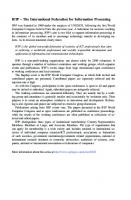
![Artificial Intelligence in Theory and Practice II: IFIP 20th World Computer Congress, TC 12: IFIP AI 2008 Stream, September 7-10, 2008, Milano, Italy (IFIP ... and Communication Technology) (No. II) [1 ed.]
0387096949, 9780387096940, 9780387096957](https://ebin.pub/img/200x200/artificial-intelligence-in-theory-and-practice-ii-ifip-20th-world-computer-congress-tc-12-ifip-ai-2008-stream-september-7-10-2008-milano-italy-ifip-and-communication-technology-no-ii-1nbsped-0387096949-9780387096940-9780387096957.jpg)
